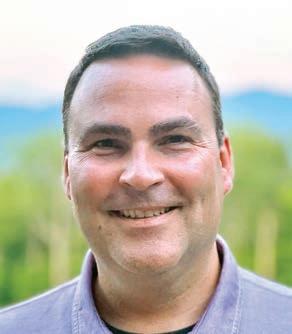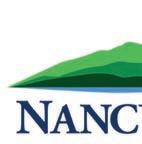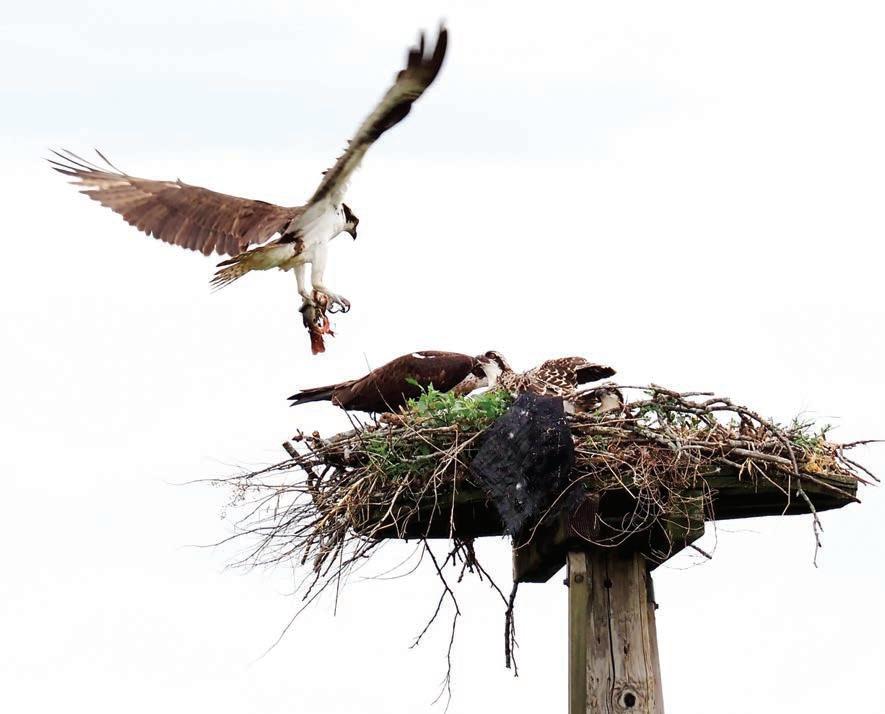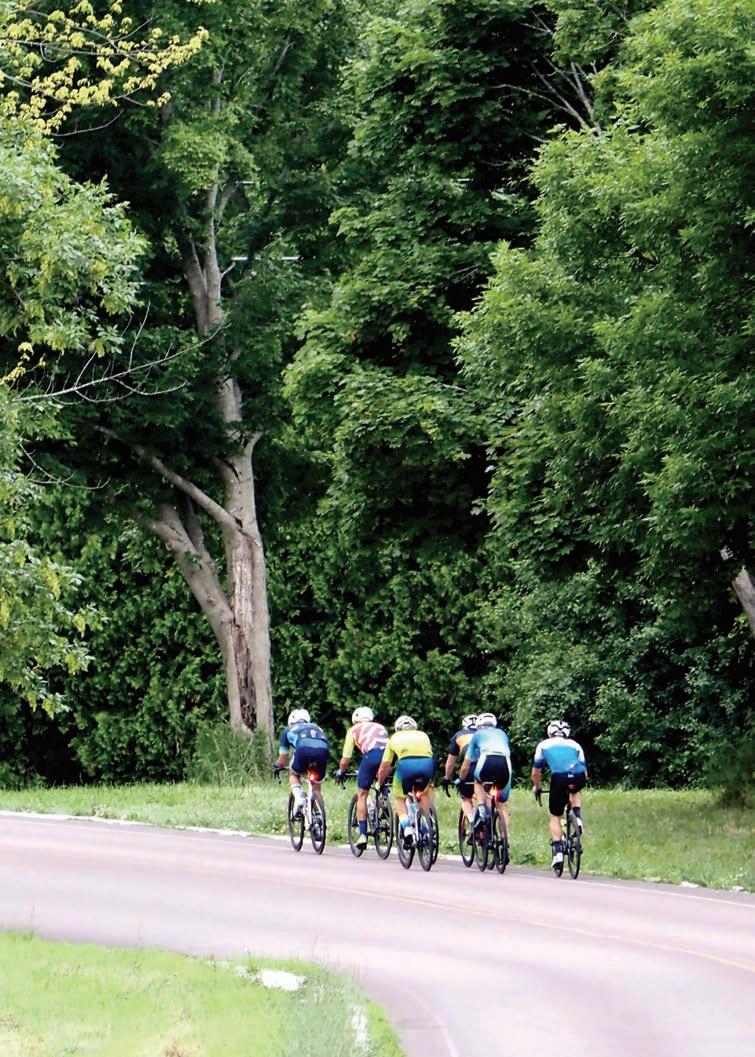
‘Don’t let age limit you,’ says Shelburne racer
Page 10



‘Don’t let age limit you,’ says Shelburne racer
Page 10

LIBERTY DARR STAFF WRITER
In the midst of a “serious” staffing shortage at the Charlotte Volunteer Fire and Rescue Service, its president, John Snow, warned town officials and residents that temporary service cuts should be expected in the coming month as the department works to
regain stability.
Snow said the service came into a “perfect storm” as it entered the summer months. The number of per diem staff — many of whom are college-aged — has dwindled, staff are taking vacations, and the service has lost another full-timer.
See CVFRS on page 9
LIBERTY DARR STAFF WRITER
Town employees should expect to pay significantly more for their health insurance packages this year, according to a Charlotte Selectboard subcommittee tasked with employee health benefits and compensation.
“There’s going to be a change, and change is really hard and difficult. We’re talking about people’s health care, their ability to care for themselves and their families, but fundamentally, to get the savings, we are going to need to make a shift in the shared burden,” board member Lewis Mudge said at a selectboard meeting last week.

The proposal also recommends limiting the 11 available Blue Cross Blue Shield plans for employees to two or three — the Bronze Select and Silver Select — both of which are currently used most by town employees.
“This adjustment will help distribute the financial responsibility more evenly between the town and its employees while still providing valuable health care
See HEALTH INSURANCE on page 13
Initial proposals recommend that town staffers who currently contribute 10 percent of their health insurance premium costs now contribute 25 percent, according to a memo written by Mudge and board member Kelly Devine.


KATE KAMPNER COMMUNITY NEWS SERVICE
The warning came Monday: The most extreme wildfires on Earth are on the rise — more frequent, more intense.
A study in the journal Nature Ecology and Evolution found that across the planet wildfires have doubled in the last two decades.
As neighbors to some of the most intense wildfires reported, Vermonters might wonder: Are they headed here?
“It may happen in the future,” Dan Dillner, forest fire supervisor for the Vermont Department of Forest, Parks and Recreation, said.
“We’re not on the level of having gigantic fires in Vermont yet,” Dillner said. But as fires continue to send smog south to the Green Mountain State, officials believe Vermonters should pay attention and prepare to protect their lungs.
Three million acres of Quebec forest burned last summer, blanketing Vermont in pollutants, Dillner said. In a recent report, the Canadian government predicted another year of high wildfire risk.
In his 12 years at the Vermont Department of Health, senior environmental health manager David Grass said he has never seen wildfires affecting Vermont’s air like last year. “2023 felt like it was qualitatively different in terms of the types of air quality that Vermont was experiencing,” he said.
The impact last summer allowed him a better appreciation for the challenges Americans experience on the West Coast.
“These health impacts and environmental exposures, it’s a part of their lives for a much longer period of time,” he said.
When wildfire smoke passes Vermont, it’s usually at high altitudes, unnoticed on the ground, said Bennet Leon, air quality planning chief for the Department of Environmental Conservation. “The wildfire smoke happening in Quebec last summer was nearby and didn’t have time to rise up in the atmosphere,” he said.
Vermont was in very high fire danger last year — a rarity when the forests are greened up, Dillner said. “A lot of the state is hardwoods, maple, birch, oaks, and when the leaves are green, the trees are not going to burn,” he said. Quebec’s forests have more soft woods like spruce, fir and pines, which can easily dry up and burn.
“Fire is natural in that ecosystem,” he

said. “What’s not natural is that the climate is changing and that (last year) had just no precipitation.”
“What’s normal has changed,” he said. “It seems like it’s time to start thinking about that and preparing.”
As wildfire numbers rise in the U.S. and Canada, homeowners may do well to start learning how to make their homes fire resilient. Dillner recommends people mow a green area next to their home that can act as a buffer. Having any dead standing vegetation up against homes can be a fire risk, he said.
“Our biggest risk is humans being careless,” he said, noting every forest fire in Vermont last year was caused by people.
“There’s no excuse for not knowing what the conditions are.”
Officials are looking at how they can get more staff trained to quell larger fires, he said. “I don’t really see Vermont having enormous fires, thousands of acres. But even a few hundred-acre fires in Chittenden County would be quite an event,” said Dillner.
Wildfires and the resulting smoke are not a new phenomenon. Vermont has been monitoring the location and effects of fires since at least 2002, with records dating back to the early 1900s, said Lesley-Ann Dupigny, Vermont’s state climatologist and University of Vermont professor.
“The topography and physical geography of Vermont can allow for more stagnation of poor air quality,” she said via email.
She points to the federal government’s Fifth National Climate Assessment, which says climate change can worsen air pollution and increase wildfire smoke.
According to the NASA Earth Observatory, carbon emissions from Canadian wildfires increased in 2023. That came alongside a spike in particles called PM2.5, according to the Yale School of Public Health. They come from smoke and can increase sky haze.
The particles’ size means they can penetrate deep into lungs. If inhaled, they can cause cardiovascular or neurological disease, respiratory illness and even death.
Grass sees impacts from smoke-filled
air as a pyramid.
First: people with symptoms like itchy eyes, a headache or a scratchy throat. “Just something that they noticed in their body that was different from what they experienced on days with better air quality,” he said.
One step up, Grass said, are people whose exposure leads them to go to a doctor.
The final level is when impacts are severe enough to put you in the emergency room, usually by aggravating existing conditions such as asthma or chronic obstructive pulmonary disease.
A study by the New York State Department of Health examined the number of emergency room visits in upstate New York during the periods the wildfire smoke impacted the state. It showed an 80 percent increase in visits on the day with the most smoke.
“I would expect that Vermont would










Tim O’Leary is the new assistant principal at Charlotte Central School.
He joins principal Jennifer Roth and special education director Beth Slater on the school’s leadership team. He started July 1.
O’Leary has worked in the Champlain Valley School District for the past six years at Shelburne Community School. He served as a digital learning leader for three years, and was also the principal of the district’s Virtual Learning Academy during the pandemic for grades five through eight.
His most recent role in Shelburne was curriculum leader and instructional coach.
Tim earned a bachelor’s degree from the University of Vermont and a Master of Arts in English from Middlebury College.
“Tim demonstrates a thoughtful leadership style that emphasizes empathy and understanding, creating a caring community where students and teachers feel valued and supported,” said Roth. “With a robust background in instructional strategies, he will collaborate to implement innovative approaches that meet diverse learning styles and promote academic success.”

O’Leary
In addition to his work in the district, O’Leary has been a program director at Middlebury’s Bread Loaf School of English and was a special educator and English teacher at Middlebury Union High School.


“Having spent the last six years at Shelburne Community School, I have come to deeply appreciate the values and strengths of our district.
I am eager to bring my experience from another district school to Charlotte and work collaboratively to ensure the success and well-being of our students, staff and community.”
The Hinesburg Garden Tour returns for its third year on Sunday, July 14, and features six gardens, including three in the village center.
One highlight on the tour is the garden of Sharon Henry and Gary Solow, which includes nine separate gardens with natural rock features from stone quarried on their property. Their primarily shaded property offers a southern view and a pond that occasionally hosts blue herons and mallards.
Not to be missed is Hidden Gardens, which showcases a variety of plantings. On the tour, see rare conifers, fully loaded mixed perennial beds with unexpected July blooms and voluptuous shade gardens bordering lengthy woodland and island beds. There is also a scree garden and a collection of pottery, sculpture and garden ornaments.
An addition to this year’s tour is an organic vegetable garden with fruit trees and flowers. Stevie Spencer started her vegetable garden in the early 1980s and recently, with her son’s help, changed the garden layout from traditional straight rows to a circular pattern, adding to its artistic beauty.
The three village gardens are within walking distance of the town hall. Set in the heart of the village, the garden at Trillium Hill Farm includes meandering pathways to explore different garden areas. Howard
Russell is the main flower gardener, while Paul Haskins tends the lawns and assists in the flower beds. As you wander the paths, you’ll encounter artwork by Russell’s nephew, Kevin Donegan.
Across Route 116, you’ll find the garden of Debbie and George Dameron. This property includes front and back yard gardens, a deep shade woodland area and a sunny field with a flower garden.
The newest garden, and the smallest at only .2 acres, belongs to Bethanne and Jeff Cellar. Their garden features perennials and edible plants, stone walls and a “living fence” formed by a trained larch.
Organized by the Friends of the Carpenter-Carse Library, the gardens are open from 10 a.m.-3 p.m. Tour participants are encouraged to visit properties in any order to distribute visitors throughout the gardens. Carpooling is recommended to help with parking at the library, where the community room will be open for restrooms, water and information. While at the library, check out the new outdoor seating area to the right of the building’s main entrance.
For information about joining the Friends of the Carpenter-Carse Library, visit carpentercarse.org/friends-of-ccl.
Garden tour tickets are available at the library and Red Wagon Plants for $20 per person.

Hinesburg Affordable Housing Committee
Carl Bohlen
This is part of a series of articles by the Hinesburg Affordable Housing Committee looking at the causes of and solutions for the current housing crisis. By now we’ve all heard the horror stories concerning housing: high prices and brutal bidding wars with offers that exceed asking prices by thousands of dollars, and very few rental options at skyrocketing costs, out of reach to many renters.
What can be done to help? The 2023 Hinesburg Housing Needs Assessment contained several recommendations to help meet Hinesburg’s housing goals.
BOLD Revise permitting fees to reduce unnecessary development costs.
It’s no surprise that developers pass along associated costs of building to the final buyer or renter. Recently, Hinesburg’s costs to hook up to water and wastewater systems in the village were the highest of surrounding towns.
Last year the town took a hard look at these fees and reduced
them significantly. Previously a new three-bedroom home would have cost just over $21,000 in application, allocation and holding fees to connect to both water and wastewater. Now that same unit results in fees of $11,460, a 45 percent reduction. The committee is working with town staff to ensure that the savings in fees is passed on to the homeowner or renter.
Currently Hinesburg imposes two impact fees on any new building: one for fire protection and one for police coverage. An average sized, new three-bedroom home would incur approximately $1,800 in impact fees. State law allows the selectboard to waive all or part of those fees for affordable housing projects, and we feel this is something to consider for future affordable projects.
As a side note, it’s interesting that Hinesburg’s impact fees are significantly less than other towns that also have impact fees for schools. For example, in Williston, with recreation, school and transportation impact fees, that same three-bedroom home would pay $7,979 in fees.
Make the permitting process shorter and more predictable.
The town has received State
Serving the community of Charlotte & Hinesburg A publication of Vermont Community Newspaper Group LLC thecitizenvt.com
Advertising Wendy Ewing wendy@shelburnenews.com (802) 985-3091 x12
Advertising Director Judy Kearns judy@otherpapersbvt.com (802) 864-6670 x21
News Editor Tommy Gardner
Staff Writers
Aaron Calvin Liberty Darr
Production Manager
Stephanie Manning stephanie@shelburnenews.com
Editor/Publisher Gregory Popa gpopa@stowereporter.com
Billing inquiries Leslie Lafountain leslie@stowereporter.com (802) 253-2101
Advertising submission deadline: Friday at 5 p.m. advertising@thecitizenvt.com classifieds@thecitizenvt.com
Editorial submission deadline: Friday at 5 p.m. news@thecitizenvt.com
Calendar submission deadline: Friday at 12 p.m. news@thecitizenvt.com
Contact: 1340 Williston Road South Burlington, VT 05403 (802) 985-3091
Neighborhood Development Area designation. This designation covers the village growth area, extends north on Route 116 to include the Haystack and NRG projects and north on Mechanicsville Road to include the Laster project. Because of this designation, qualified mixed income housing projects that receive extensive local review are exempt from Act 250 review, a large cost and time savings for developers and, ultimately, homeowners and renters.
According to town planner Alex Weinhagen, “The zoning modernization proposal will also help streamline zoning regulations and ensure more options for housing — both new and infill development.”
The town should conduct a review of the density bonuses
offered in its zoning regulations to determine which one have been successfully used.
Both nonprofit and for-profit developers have commented that the most sure-fire way to increase the number of units and lower costs is to build more housing on less land. The current zoning proposal would do away with the many previous density bonuses in favor of two: one for affordable housing and one for smaller sized housing.
If a developer proposes to include affordable housing or smaller sized units, they will receive a corresponding increase in the number of units allowed within the constraints of the regulations.
So, what impact will these changes have on housing in
Hinesburg? Will you be able to buy a new home for $150,000 like the good old days? Sorry folks, those days seem to be gone.
However, we should all embrace anything possible to increase the number of homes built at lower cost. These changes will support those efforts.
Young couples or families just starting are looking at home prices well north of $500,000 or rents more than $2,500 a month. Both are unsustainable situations. For more details, refer to the Hinesburg Housing Needs Assessment, which is available at hinesburg.org.
Carl Bohlen is a member of the Hinesburg Affordable Housing Committee.
Don Tinney
No political insiders in Montpelier were surprised when Sen. Jane Kitchel condemned the Scott administration’s proposal to zero out the education fund reserves to provide short-term property tax
relief, saying “that is a practice that we never ever had considered, or would consider, as fiscally responsible use of a reserve.”
In her long, distinguished career as a political leader, Kitchel has always been fiscally responsible while working diligently to meet the human needs of Vermonters, so no one was surprised
when she voted to override the governor’s veto of the education funding bill. She had the political courage to do the right thing to protect Vermont’s public education system and to provide services to Vermont’s most precious resource,
See TINNEY on page 5




PHOTO BY JESSICA LOUISOS
A Lewis Creek Association project team visits landowners at a potential tree planting site along Lewis Creek. One upcoming project will include planting trees and shrubs along the creek in Hinesburg, which is expected to be completed this fall. A second project, in Starksboro, would fix a gravel road that has been eroding, dumping sediment and pollutants into the creek. It will be fixed if the association can secure funding.
continued from page 4
our children.
Every legislator struggled with the education funding bill. They knew it would be an unpopular decision that would lead to increased property taxes, yet voted to support public schools, the cornerstone of democracy. Legislators who voted to support the children and youth of Vermont demonstrated true political courage. They chose to support sound public policy and fiscal responsibility without regard for their own political popularity.
Ever since Ronald Reagan entered American politics, Republican politicians have generated political popularity by promising tax cuts. Grover Norquist founded the Americans for Tax Reform in 1985 and has been one of the chief architects of the current GOP’s dogma of reducing taxes and shrinking the size of government.
Former Republican Sen. Alan Simpson of Wyoming was particularly critical in describing Norquist’s position as “no taxes, under any situation, even if your country goes to hell.”
This anti-tax mentality led to the 2017 Trump tax law which cost the government $1.9 trillion in revenues and failed to deliver any economic benefits to average Americans.
Vermont’s current governor follows Norquist’s simplistic directive in his refusal to increase revenues to support essential services to Vermonters. He knows that one way to remain popular is to continue to rail against taxes.
It’s a winning formula since no one wants to pay higher taxes. While “no new taxes” is a popular campaign slogan, it does nothing to improve public policy and ensure services for Vermonters, and it certainly doesn’t display an ounce of political courage. The only thing this affordability argument does is fuel the anti-government attitude and rhetoric on social media and at Trump rallies.
On June 17, we heard this Republican anti-government stance articulated by Republican Rep. Patricia McCoy of Rutland County speaking against the education funding bill that would provide adequate resources for public education.
“This bill continues to feed the beast,” said McCoy, who is House Minority Leader.
Vermonters know the importance of public education in meeting the needs of our children and youth and do not see our schools and the students they serve as any type of beast.
On that same day, Republican Rep. Michael Morgan of Milton, said, “My constituents, as a whole, have reached out begging for relief in this arena. Why we are not working to find a solution for relief now is beyond my comprehension.”
Perhaps Morgan’s Statehouse colleagues could help him comprehend how they worked during the entire legislative session to find a solution and how the governor’s proposal was so fiscally irresponsible that it was panned by


Wall Street. While that might be beyond his comprehension, many Vermonters cannot comprehend how a Republican can be in the governor’s office for eight years — after being lieutenant governor for six and a state senator for 10 — and offer no plan to find the necessary revenues to support an education system that meets the needs of young Vermonters and their families.
No new taxes is neither a plan nor effective public policy.
Vermonters have made it abundantly clear that they want a new equitable education funding system. Thousands of citizens voted against school budgets this year who had never considered voting against a school budget in the past, but were voting against severe property tax increases, not against their local school budgets.
Since 2018, Vermont-NEA has argued that Vermont must shift education financing from property tax to income tax, allowing all Vermonters to pay their fair share. Rather than blaming Democrats and calling them arrogant, perhaps the governor can find the political courage to let go of his Norquist pledge card, roll up his sleeves and work with the legislators who were voted into office by the same Vermonters who voted him into office, and build a strong and effective state government. That will take real political courage.
Don Tinney, a longtime high school English teacher, is president of the Vermont-NEA.


The Buck Hollers Community Notes
The Age Well meal pickup for Wednesday, July 17, is from 10 to 11 a.m. at the Charlotte Senior Center. The meal features chopped beef steak with mushroom gravy, mashed potatoes, broccoli, wheat roll, pumpkin cookie, and milk.
You must pre-register by the prior Monday at 802-425-6345 or meals@ charlotteseniorcentervt.org. The suggested donation is $5. Check the website for last-minute cancellations at bit. ly/3FfyLMb.
The Lake Champlain Maritime Museum summer party features live music, food and drink, prizes and exclusive after-hours access to exhibits. It will be held Friday, July 12, 5-8 p.m. at the museum, 4472 Basin Harbor Road, Vergennes.
As a special experience for 2024, party guests will also be the first to preview the museum’s newest exhibit about canal boats stories discovered from shipwrecks.
Tickets include all food for the evening and one raffle ticket. Donations support the museum’s free admission and pay-whatyou-can summer camps. More at lcmm.org.
Shelburne church, Age well host July luncheon
Age Well is offering a luncheon on Tuesday, July 16, in the St Catherine of

The high-energy, up-tempo tunes and soul-stirring ballads of The Buck Hollers
and enjoy local music in good company. And it’s free. The Charlotte
Senior Center.

Siena Parish Hall, 72 Church St. in Shelburne.
The menu is egg salad with celery and onions, coleslaw, spinach salad with chickpeas and veggies, Italian dressing, dinner
roll, Congo bar, pears and milk. You must register by Wednesday, July 10, to Kerry Batres, nutrition coordinator, 802-662-5283 or email kbatres@agewellvt. org. Tickets are also available at the Age
Well Office, 875 Roosevelt Highway, Suite 210, Colchester. Check-in time is 11:30 a.m. and the meal will be served at noon. There is a $5 suggested donation.


FIRES continued from page 2
experience similar impacts,” Grass said.
On the other side of Lake Champlain, the Vermont Department of Health found an increase in emergency room visits when Vermont saw widespread haze from the northern fires, especially for those with COPD. “You could see a spike that seemed to occur at the same time,” said Grass.
People who have preexisting breathing conditions, don’t have housing or who need to work outdoors are at higher risk for smoke-related lung problems, he said.
Grass isn’t concerned Vermonters are at risk of that level of exposure, but he hopes they “can take preventative steps in order to minimize their exposure.”
Leon, the air quality official, urges people to watch for symptoms like coughing or shortness of breath — signs to “take it easy” and find a place with better air quality. He also advises people to watch air
quality alerts using Vermont Alert or EnviroFlash, and if quality is especially bad, people can even wear filtered masks.
“There’s a lot of fire north to us, and when the wind changes direction, it brings it to us,” Dillner said, comparing it to the movement of a campfire. “Sometimes the smoke blows on you, and sometimes it doesn’t.”
Data doesn’t show Vermont’s getting more fires each year, Dillner said.
“I do think things are changing,” he said. “I think we’re getting even more periods of extended dry weather with a lot more potential for large fires.”
Kate Kampner is a reporter with the Community News Service, a program in which University of Vermont students work with professional editors to provide content for local news outlets at no cost.




50% OFF Annual 6 Packs or 8 Packs for $15 (Reg. $37)
Annuals $4 for 4” Pots or 10 for $30 (Includes Proven Winners!) 50% OFF Hanging Baskets (Start at $9.99)
• Perennials
• Planters and Pottery
• Fruit Trees
• Blueberries
• Compost, Topsoil and Mulch
*Closed Thursday, July 4










































PAMELA POLSTON CONTRIBUTOR
On his website, this year’s Herb Lockwood Prize winner notes a string of past occupations, including but not limited to assembly line worker, librarian, janitor, carpenter and house painter. However, most Vermonters have likely known him in more celebrated roles: musician — on saxophone and guitar — composer, dance program collaborator at Middlebury College, arranger and producer and teacher. And many probably know he’s the recipient of a Tony Award.
Our winner has had a long and fruitful journey in the Vermont music scene and beyond. I first became aware of him in the 1980s when he was performing in an acoustic band called Feast or Famine. Several bands, genres and years later, as he led the “acid jazz” group viperHouse, I began to recognize not only his incredible versatility and musical curiosity but his significant mentorship of other, younger musicians. Some of the players who came into their own in viperHouse would become in-demand jazz musicians in Vermont doing their own original work.


“Hadestown” was nominated for 14 Tony Awards and took home eight, including Best Musical, in 2019. Among them also was the award for Best Orchestration, which our man shared with New York musician Todd Sickafoose.
“I am the only person who has played every live performance of ‘Hadestown,’” he told Eva Sollberger for an episode of her video series “Stuck in Vermont.” “There’s a lot of heart,” he added. “Maybe that’s the Vermont part of the show.”
There is probably little doubt among this audience who I mean by “our man.” A resident of both Lincoln, and a remarkable place called Hadestown, Michael Chorney is the 2024 recipient of the Herb Lockwood Prize.
Chorney, a Vermont musician, composer and arranger, received the $10,000 Herb Lockwood Prize at Burlington City Arts Center on June 22. This marks the eleventh time the Herb Lockwood Prize has been awarded since 2014.
In nearly a dozen ensembles, in styles ranging from folk to jazz to what he dubs “instrumental psych-rock film scores for nonexistent movies,” our man has continued to compose original works, to surpass himself in creativity, and to influence and collaborate with many others.
Chorney, a Vermont musician, composer and arranger, received the $10,000 Herb Lockwood Prize at Burlington City Arts Center on June 22.
That fake film-score band is his current project, named Freeway Clyde. Their latest record, reviewed by Seven Days music editor Chris Farnsworth earlier this year, features music from the “lost” film “Sept Etoiles” (“Seven Stars”), allegedly recorded in Portugal. Unfortunately, the director was arrested on smuggling charges — again allegedly — and the film fell apart.
“Even if the fake film never saw the light of day, the very real soundtrack fortunately did,” Farnsworth writes. “It’s some of the band’s best work: a clever, rarely still record that moves between sunny jazz and ambient electronica with ease.”
Terrific music for apocryphal films aside, our man’s best-known collaboration was with singer-songwriter Anaïs Mitchell on the wildly successful folk-rock opera “Hadestown.” Still running on Broadway, the show, which is an expansive retelling of the Greek myth of Orpheus and Eurydice, had its more stripped-down debut in Vermont. I had the good fortune to see the nascent production in a small Burlington venue, then a bigger and longer version off-Broadway, and finally the fully developed show on Broadway, which was utterly thrilling.
The prize was founded by Todd R. Lockwood of South Burlington and some like-minded people from the Vermont arts community. It has no application process, and artists do not know they are being considered for it. Its purpose is fourfold: To validate the work of the recipient, to energize that artist’s future, to encourage other artists to work ambitiously and to honor the memory of Herb Lockwood’s (Todd’s brother) by continuing his inspirational influence.
Prior recipients include actor and theater director Steve Small, fine artist and typographer Claire Van Vliet, filmmaker Nora Jacobson, author Howard Frank Mosher, puppeteer and artist Peter Schumann, musician and public radio host Robert Resnik, dancer and choreographer Hannah Dennison, jazz musician and teacher Ray Vega, poet Kerrin McCadden, and film director and impresario Jay Craven.
“Herb Lockwood was an inspirational figure in the Burlington arts and music scene in the 1980s. His impact on the region’s arts and artists has proved to be enduring and profound. The breadth of art forms he practiced, and his influence on other artists in all manner of disciplines, created a legacy that remains inspirational decades later,” according to Burlington City Arts’ announcement of the prize.
Herb Lockwood died in a Burlington workplace accident in 1987 at age 27.
Pamela Polston, a co-founder of Seven Days newspaper, attended the Lockwood Prize ceremony.
Shop local and please remember our advertisers!
Total incidents: 41
Traffic stops: 13
Arrests: 1
June 25 at 3:51 p.m., officers responded to a two-car motor vehicle crash on Hollow Road.
June 25 at 4:28 p.m., an officer investigated a juvenile issue on Hillview Terrace.
June 26
June 26 at 3:30 p.m., court paperwork was served to an individual on Route 116.
June 27 at 8:37 a.m., a 911 hangup on Richmond Road was investigated.
June 27 at 7:25 p.m., police investigated suspicious activity on North Road.
from page 1
“So, all of a sudden, you’re down 25 percent of what you had the day before. There is just not enough resilience in that pool of people” he said. “We’ve kind of hit a perfect storm in the last month and a half that has robbed us of the resilience to cope with this without having any effect on our service.”
A year ago, he said, the service was able to come close to nearly 100 percent availability, but this year is the first year they’ve seen “material difficulty” staffing all available shifts. It’s especially difficult, he said, since the service committed to staffing seven fulltime positions last budget cycle and was able to fill all seven positions by last fall.
But when the former fire chief, Justin Bliss, announced he was resigning last July, the service saw full-timers drop, and the effort to hire another chief has made little progress.
“Of course, one of the roles of the chief is to recruit the people to fill the jobs and with a few people leaving the positions between November and December last year, we were down to four of seven positions,” he said, noting that number has now dropped to three due to a workplace injury.
While the service also utilizes some part-time staffers, the department is very dependent on per-diem staff to step up and fill roles, but those are entirely voluntary and have their own lack of reliability.
“We have a long history of having med students work in our service,” he said. “But they hit times of the year when they just can’t do it, or they just aren’t in the area. That’s typically the summer.”
June 28 at 8:16 a.m., an officer responded to a medical emergency on Commerce Street.
June 28 at 12:14 p.m., an officer investigated a citizen dispute on Farmall Drive.
June 29 at 6:23 p.m., officers responded to a juvenile issue on Piette Road.
June 30 at 11:53 a.m., harassment by phone was investigated.
June 30 at 2:47 p.m., an officer assisted with an animal problem on Upper Access Road.
June 30 at 4:52 p.m., an officer responded to a three-car motor vehicle crash on Route 116. Nathan Redmond, 39 of Vergennes, was cited for driving with a criminally suspended driver’s license.
now have to rely more on its mutual aid partners to respond to calls, but that can mean that those in need of an ambulance in Charlotte may wait longer than usual.
“This is something we do for the other services very regularly. In fact, most of our calls are mutual aid calls,” he said. “But it’s not something that we customarily have to rely on. But now we do and so far, our mutual aid partners have been very good about responding when necessary.”
Snow likened the situation at Charlotte Volunteer Fire and Rescue Service to many fire and rescue services in the area that are experiencing staffing shortages. He attributed the situation to a diminishing pool of trained emergency medical technicians and many local services competing for the same people. As well, he’s seen a massive decrease in volunteerism.
“To some degree, we’re cannibalizing each other in our recruitment of staff,” he said. “Not intentionally, but there’s such a limited pool of people who are qualified and interested to work at the various smaller services that it’s hard.”
Snow said the department is reaching across the state to find people. Even when the service was fully staffed, he said that a few employees were traveling from places like St. Johnsbury and Lyndonville but making that commute to Charlotte was not sustainable for a long period of time.
The department’s struggles, like those he’s heard from others across the state, highlight the need for regionalization that may need to be realized sooner rather than later, he said.

The osprey family in Shelburne keeps an eye on the surrounding territory as an adult, seen above, brings prey back to the nest.

very inefficient form of regionalization, he added.
“I wish I had a nickel for every time I have said we must get serious about regionalization,” he said. “Doing it town by town, in these smaller towns no longer makes sense. In essence, we’re a regional service based on when other services can be available or not. So, because of the mutual aid system, all that is an extremely inefficient regional service. We could make it so much more efficient.”
He said the conversation is certainly one that departments are having, but there is still a long way to go.
The department, for now, is working to regain its staffers by using just about every financial incentive it has and has even committed to subsidizing the certification processes for those who may be looking to join. CVFRS
It’s likely the department will
The mutual aid system is a




LIBERTY DARR STAFF WRITER
For some, retirement is a time for relaxation. For others, like Susan Grimes retirement is just an opportunity for more adventure.
In her case, that includes completing the Marathon Des Sables, a 156-mile race over six days in the Western Sahara in Morocco.
“It just seemed pretty intriguing,” she said. “To be able to be in the Sahara for some days at a stretch and survive, let alone be in a race.”
Dubbed the hardest footrace on earth, Grimes was one of 60 people from the U.S. and over 857 participants who completed the race. As if completing a race of that size wasn’t enough of a reward, Grimes also placed first for a woman in her age bracket.
“My goal was to just complete it,” Grimes, a longtime Shelburne resident now living in South Burl-
ington. “There weren’t that many ladies in my age group. But still, I was just thrilled to finish it and to be able to be like ‘Hey, you know what, I can do this.’”
The trek was a race against both time and natural elements. From 100-degree afternoon temperatures to heat exhaustion and the rapid loss of hydration through sweat, each day proved to have its own set of hardships.
Grimes alternated between walking, power walking and running, which was usually solely to finish that day’s stretch of miles before it got unbearably hot.
“You really had to pace yourself,” she said. “It was important to stay hydrated because you’re carrying everything. So, running at home I’m not used to carrying a backpack that has everything I need for the week, the heaviest part being the food.”

Organizing the pack and finding the right balance of food and weight also proved to be a unique challenge.
“There was a mandatory checklist of things you were required to carry, as well as the number of calories that were minimum requirements per day,” she said, adding that at many points she was forcing herself to eat and drink since hunger and thirst seemed to fade after each mile.
The day would usually begin at 4:30 a.m. as runners prepped their bags. The race would officially begin around 6:30 a.m., with “Highway to Hell” blasting out over the megaphones as racers lined up.
The runners in the front were usually Moroccan, she said, adding that their expertise in running in the sand gave them a considerable advantage.
But, in certain aspects, the sand dunes mimicked snow-dusted hills and mountains, which being from Vermont, Grimes could navigate well.
“I think being from Vermont I loved it because we were hiking up a little hill and it was kind of rocky and you go down this huge sand dune so it was kind of like going down snow,” she said, noting that this moment of joy came on the longest day of the race as the team was doing backto-back marathon-length stretches.
“I just kind of sat back and glided down and the scenery was just stunning,” she said.
She recounted one of the hardest days in the race happened on day two walking on a dried-up seabed.
“It was just flat, cracked earth that seemed to stretch on forever,” she said. “You’re really having to dig deep and stay positive that you can do this. That was hard just because it was still early in the week and it was just so hot and you’re questioning to yourself, ‘What am I doing?’”
While the long days were physically taxing, they were also mentally draining. Grimes said she found herself digging deeper into herself. Although she spent months before this doing durability training, the strain on her emotional psyche was far greater.
But one thing the race did teach her is that staying in a negative headspace adds nothing to your desired outcome. In her case, it was finishing the race, but




that lesson can easily translate to almost anything else in life.
“One thing I have learned is that, of course, we all have our low moments, and maybe something didn’t go the way you expected, but don’t stay in that negative zone, just readjust, and try to stay positive. Sometimes I wound up counting just to pass the time,” she said.
Aside from moments of solitude, Grimes said that being surrounded by others who held similar passions had not only inspired her to push on, but she also developed lifelong friendships and found a new community.
“You meet some really amazing people doing this, she said, adding that she bunked in the tents each night with four women from the United States. “We’re such close friends now. But everyone was so positive and encouraging, no matter where people
were from. I never heard anyone complain. Everyone was going through the same thing.”
This race is only just the beginning for Grimes. As one of 102 U.S. Centurion members — awarded to people to people who walk 100 miles within 24 hours — she is off to the United Kingdom in August to attempt to become the first American woman to win a Centurion race on that side of the pond.
Although she now considers South Burlington home, she said that the Shelburne community, specifically at the Shelburne Athletic Club, is where her roots are, and everywhere she travels she is bringing a little piece of home with her.
“It’s about saying yes to the challenge while I can still do it,” she said. “I hope to encourage other people to not let age be your limiting factor.”

When you support your local newspaper, you support your community.
When you support your local newspaper, you support your community.

The Outside Story
Michael J. Caduto
Road crews across the United States use more than 24 million tons of road salt (sodium chloride) to melt ice and snow each year — triple the volume used in 1975. Road salt is cost-effective and prevents traffic accidents. But there is an ecological downside to this practice: rain and meltwater dissolve and wash road salt into streams, rivers, lakes and ponds, where it severely impacts aquatic life and degrades freshwater environments.
Chloride also enters waterways from other sources, including fertilizer runoff, septic systems, wastewater and leachate from landfills. But more than 90 percent of the chloride polluting our waterways comes from road salt. Fifty years after Interstate 93 was constructed through Woodstock, N.H., chloride levels have increased fourfold in nearby Mirror Lake.
“Road salt has been the number one contributor to increasing chloride in our waterways,” said Andrea LaMoreaux, president and policy advocate for NH LAKES, a non-profit organization focused on preserving and restoring the health of New Hampshire’s nearly 1,000 bodies of water. “According to the New Hampshire Department of Environmental Services, in 2008 there were 19 chloride-impaired waterbodies in New Hampshire. In 2020, there were 50.”
ic food webs. Water flea populations, for instance, can drop 50 percent even where chloride levels meet water quality guidelines. Zooplankton consume algae, and are in turn eaten by aquatic insects, small fish, and other animals moving up the food chain. Absent healthy levels of zooplankton, populations of cyanobacteria (which can be toxic) are more likely to increase, as are invasive species tolerant of high salinity.
In addition, LaMoreaux notes that chloride-polluted water is denser than freshwater, which means it can become concentrated at lake bottoms. In extreme cases, this can impede the vernal and autumnal vertical turnover of lake waters essential for distributing oxygen and nutrients to aquatic species.
The state of Vermont emphasizes using sufficient road salt to maintain “safe roads at safe speeds,” rather than a bare-roads policy.
Citizen scientists provide crucial information to government agencies and environmental organizations that protect our waterways. The New Hampshire Department of Environmental Services Volunteer Lake Assessment Program coordinates a statewide network of monitors, incorporates their findings into water quality research and management, and informs biologists about conditions in water bodies. The Watershed Management Division of Vermont’s Agency of Natural Resources has a similar program and distributes the “Vermont Volunteer Surface Water Monitoring Guide.”

Road salt washes into waterways, especially during heavy storm runoff. Although road salt is used during winter, the highest chloride levels typically occur during summer’s hot dry weather, when streams slow to a trickle and water levels drop in lakes and ponds. Monitoring data from Stoney Brook in Grantham, N.H., which receives runoff from nearby Interstate 89, revealed chloride levels during severe summer heat and drought in 2019, 2020 and 2022 that were 10 times the levels recorded during wet winter months.
Elevated chloride kills zooplankton, the minute animals that form critical links in aquat-
James Lantz, a retired geologist, has been monitoring and recording conductivity levels, which serve as an indicator of chloride concentrations, in the Eastman Lake (also called Eastman Pond) watershed in central New Hampshire for the past 8 years, while also studying historical trends of nearby lakes. In the past 34 years, the conductivity of Eastman Lake has doubled, rising steadily since 1987 to four-to-five times the state median level.
“The field data suggests that the main culprit is de-icing (salt) via runoff primarily from I-89,” Lantz said. “Perhaps half of this salt ends up in shallow groundwater, where it has been building up over many years. This conclusion is support-
ed by field measurements during low flow in summer, when the larger proportions of stream flows are sourced from groundwater.”
Salt reduction zones can reduce chloride levels in nearby bodies of water. Vermont’s management program emphasizes using sufficient road salt to maintain “safe roads at safe speeds,” rather than a bare-roads policy that would introduce considerably more salt into the environment. Drivers are asked to employ patience and preparedness by not expecting bare roads immediately after storms, staying off snow-covered roads unless travel is essential, and running
winter tires for traction.
The NH LAKES LakeSmart program encourages property owners to employ contractors who follow the Green SnowPro Certification Program guidelines, which mitigate road salt while emphasizing public safety. In 2022 the New Hampshire Department of Environmental Services awarded $80,000 to Merrimack Village for implementing a decade-long, watershed-wide “best management practices” program for minimizing road salt and reducing chloride pollution.
From driving habits and road management to citizen science,
everyone can help reduce chloride pollution. “Ask yourself how you would balance road safety and lake health,” Lantz said. “We can do better.”
Michael J. Caduto is a writer, ecologist, and storyteller who lives in Reading, Vermont. He is author of “Pond and Brook: A Guide to Nature in Freshwater Environments.” Illustration by Adelaide Murphy Tyrol. The Outside Story is assigned and edited by Northern Woodlands magazine and sponsored by the Wellborn Ecology Fund of the New Hampshire Charitable Foundation, nhcf.org.
continued from page 1
benefits,” they wrote.
The shift in cost sharing, which has historically been outlined in the town’s personnel policy, also means a change in the reimbursement structure for out-of-pocket expenditures. Under the new proposal, employees will be required to pay 25 percent of those costs with the town covering 75 percent, down from the 90 percent the town currently pays.
In addition, the plan would change the order of payment for these out-of-pocket expenses “to give employees more of a stake in their health and wellness.” Essentially staffers will be expected to pay the first portion of out-of-pocket expenses and the town will reimburse the remaining 75 percent.
“In the hopefully unnecessary event of a major illness, employees would be well covered,” they wrote. “This change will encourage employees to make cost-conscious health care decisions and will also help control the town’s overall health care expenditure.”
While not officially adopted by the
selectboard, this promised plan to cut nearly $30,000 in benefit packages has been in the works since 2023 when the selectboard’s initial budget was narrowly voted down on Town Meeting Day by taxpayers who cited high tax increases.
The months that followed boiled over in a contentious battle between some taxpayers upset by high employee costs, and workers who said they felt “blindsided” by proposed changes to their compensation packages.
The board that year charged a working group, spearheaded by Devine, to find cost savings for the town, but even members of the group were divided on where to make cuts.
To find structural changes in how the town could curb health care spending, the board charged Devine and Mudge to work with Blue Cross Blue Shield on potential solutions.
Representatives from the insurer have advised that the town should anticipate rate increases from 10 to 19 percent.
“This is not something that we’ve just
To advertise in the service directory email: Advertising@thecitizenvt.com or call 985-3091
sort of pulled out of thin air over the last few weeks or months. This was something we started talking about late last fall,” Mudge said, adding that the high cost of employee benefits and compensation packages have consistently been brought to the selectboard for at least the four years he’s been on the board.
It remains uncertain exactly how this proposal will pan out, especially since some employees have taken the first steps to join a union to have more of a voice in decision-making that concerns compensation and benefits.
Ten town employees — five library workers, the zoning administrator and town planner, the planning and zoning assistant, the assistant town clerk and a volunteer coordinator at the Charlotte Senior Center — are eligible to be represented by the American Federation of State, County and Municipal Employees Council 93.
Mudge was mum on whether the board has considered how unionization efforts may change this proposal once negotiations for a union contract begin, which would supersede the town’s personnel policy.
“I don’t have any comment with regards to the union,” he said.
The proposal is expected to be reviewed more thoroughly by the selectboard and employees who can offer suggestions for adjustments. After an open meeting with public input, Mudge and Devine hope the proposed health care policy will be completed by Sept. 1.
The week-long bait drop is a cooperative effort between Vermont and the U.S. Department of Agriculture Wildlife Services to stop the spread of the potentially fatal disease.
According to a petition to the Vermont Labor Relations Board, most of these town employees have indicated their intent to join the union.
continued from page 2 saliva. ways fatal treatment 100 percent a person So far have tested those have According animals mal behavior, an animal it. People animals
“We haven’t even started talking to the employees yet, and that’s certainly in our timeline,” Mudge said. “These have already been difficult conversations to have because we know this is going to impact town staff, and we know when you talk about reducing the cost of the benefits package, that savings needs to come from somewhere, and that’s going to come from, unfortunately, our staff bearing more of a burden with regards to what they pay in and what the town pays in.”
Rabies is a deadly viral disease of the brain that infects mammals. It is most often seen in raccoons, skunks, foxes, and bats, but unvaccinated pets and livestock can also get rabies.The virus is spread through the bite of an infected animal or contact with its





Have a struggling student?

Foster motivation and purpose with proven assessments and tools for life skills development. We can help with gap year, career and parallel education planning.
Have a struggling student?

Contact Ben Mason ben@masonconsult.com • 617-283-6010
inquiries: ben@masonconsult.com or call (617)




email: Advertising@thecitizenvt.com or call 985-3091
















Last year, Vermonters threw away 71,113 tons of food scraps which ended up in our only landfill. Equal to 242 pounds of food scraps per person per year.
CSWD’s Organic Recycling Facility (ORF) and our six Drop-Off Centers accept food scraps from residents and businesses to keep them out of Vermont’s only landfill.

For information scan or visit cswd.net/a-to-z/food-scraps

All riders must sign an annual waiver. Cyclists should sign up for each individual ride so ride leaders know how many people to expect.
For club rules and to join, visit gmbc. com.
Thursday, July 4
Salisbury ice cream social: From Hinesburg on rolling gravel hills.
Meet at 1 p.m. in Middlebury at the 3-mile bridge. The leader is John Bertelsen, 802-864-0101, jo.bertel@ gmail.com.
Saturday, July 6
Gravel MUP #1: Dirt roads in the Hinesburg Charlotte area including Guinea, Bingham Brook, and Garen roads
Meet at 9:15 a.m. Charlotte Elementary School. The leader is Brian Howard, 802-304-0610, bjhowd@gmail.com.
Saturday, July 7
Willsboro Wanderer: 40- and 55- mile options of hilly terrain on low-traffic roads in New York.
Meeting at 8:30 a.m. for the 9 o’clock
ferry, Old Champlain Flyer parking lot, Ferry Road, Charlotte (not the ferry parking lot). Leader is Kevin Batson, 802-8252618, kevbvt@gmail.com.
Sunday, July 16
Not Quite Quebec: 51- and 64-miles rides on low traffic roads near the Canadian border. The route crosses the Missisquoi River twice and travels along the shore of Lake Carmi.
Meet at 8:45 a.m. at Tractor Supply Company at exit 20 off I-89. The leader is Dave Merchant, 802-825-3808, merchand59@gmail.com.
Saturday, July 20
Gravel Ride TBD: The leader is Brian Howard, 802-304-0610, bjhowd@gmail. com.
Sunday, July 21
Pleasant Valley Voyager: 30- and 50-mile loops along Pleasant Valley Road in Underhill and Cambridge.
Meet at 9:15 at Brown’s River Middle School. Leader is Matt Kuivinen, mattkui@earthlink.net.